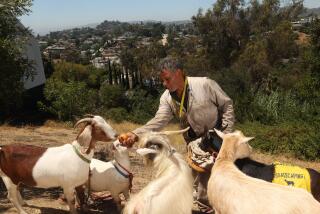Market Watch: Goatherdâs life a rugged climb
Reporting from Ontario â â One of very few goat dairies in Southern California, and one of the newest and best cheese vendors at local certified farmers markets, is Drake Family Farms, which started selling an excellent fresh, mild chevre cheese a little over a year ago. It remains to be seen, however, whether its high quality and local production will allow it to overcome the brutal economics of artisanal, farmstead cheesemaking in a world of cheap commodity cheese.
âWe make cheese from milk from our own goats, so we have complete control of the entire process,â said Daniel Drake, 40, on a visit to his farm last Monday.
He offered handfuls of hay to the goats, which came running and raised their feet on the wire fence of their pen to present their heads to be petted, like playful dogs. His face beamed boyish enthusiasm, tempered by the strain of trying to find a way to turn a longtime dream into a paying business.
The saga began in 1880 when his great-great-grandfather, Edward Drake, joined the Church of Jesus Christ of Latter-day Saints and emigrated from England to Utah. He settled on 20 acres in West Jordan, near Salt Lake City, where he raised alfalfa and dairy cattle.
A century later, Edwardâs great-grandson Ron and Ronâs wife, Jeanette, still operated the farm, although half the acreage had been sold. They had eight children, including Daniel, who bought his first goat, Glacier, in 1984, when he was 12 years old, for a 4-H project. (He and his brother David were actually saving up to buy a cow but soon realized that this would take too long.) He became smitten with the goatsâ quirky, inquisitive personalities. The family started raising goats commercially in 1997 and still makes a modest living selling cheese, milk and soap at Utah farmers markets and a farm store.
After college, Daniel attended veterinary school at UC Davis, and in 2000, âDr. Danâ moved to Southern California to join an established practice, taking care of dairy cows. Five years later, after the senior doctor retired, he took over the practice.
His grandmother Emily, who owned the farm, died two years ago at age 97, leaving the property to her five children, including Ron. Surrounded by development, the land is quite valuable, and it seemed inevitable that it would be sold and Danielâs beloved goats left without a home.
Determined to save the family farm, Daniel tried playing the lottery, and when that didnât work, he came up with a more realistic plan when a client, Summerhill Goat Dairy, outgrew its premises in Ontario and moved north to Hanford. In late 2010, he rented the property, 5 acres in the dairy district near the border with Chino, and brought 146 goats from his familyâs farm in a trailer to start a new farm.
âI thought, âMy parents do well at farmers markets in Utah, and Southern California has gazillions of farmers markets that operate year-round,â â he recalled.
The herd grew as his goats had kids and now numbers 259, all of which are named. Most are raised by hand on bottles and are very affable; the few that are raised by their mothers are more standoffish. They are housed in eight barns, with access at all times to outside yards, and are fed a simple diet of hay and rolled barley. Although famously omnivorous, goats are picky eaters, and Drake had to buy a cow specifically to consume their leftover hay.
Most of the herd, of course, are females, called âdoesâ; the strong-smelling males, a few of which are kept for breeding, are called âbucks.â (ââNannyâ and âbillyâ are not proper terms for dairy goats,â said Drake. âIf you said that to dairy goat professionals, they would be offended.â) The rest of the males are sold when young to mostly Latino buyers who raise them for meat.
Two sturdy Great Pyrenees dogs protect the flock. Soon after Drake moved his herd here, and before these guards were in place, wild dogs killed one goat and attacked two others, which barely survived.
Drake has four breeds of goats, all descended from prize-winning stock, costing up to $1,200 a head, and they are registered with the American Dairy Goat Assn. Saanens, named for a valley in Switzerland, are large and white, with erect ears and a calm manner. They produce the most milk, but Nubians, which have big, floppy ears and Roman noses, produce the richest milk, with the highest butterfat and protein content. They also raise Snubians, which are a Saanen-Nubian cross, and Alpine goats.
Three employees milk the goats twice a day, starting at 5:30 a.m. and 5:30 p.m. They attach vacuum tubes to the teats, which they carefully clean and disinfect to keep them healthy.
âThe key to making good cheese is having healthy goats with healthy udders, and to keep the milk fresh by keeping it cold,â said Drake.
Twice a week the milk is pasteurized in a big tank at 145 degrees for half an hour, all documented on charts for inspectors. The cheesemaker then adds lactic cultures imported from France and vegetable rennet. When the curds form, the cheese is moved to a draining table, and the whey is drawn off, to be fed to the goats. Finally some of the cheese is blended with flavorings such as herbs, garlic, pepper, apricot preserves and honey to make eight flavors in addition to the plain.
Before investing his life savings in the goat dairy, Drake carefully penciled out the economics, but he soon found that he had underestimated the costs. Part of that was bad luck, since drought conditions in Texas caused the price of hay, which accounts for half of the cost of production, to triple over the last several years. Electricity, labor and taxes are also much higher than in Utah, so it costs 2.3 times as much to farm here compared with the home ranch, he said
Also, he found that he often couldnât get into some of the most desirable farmers markets, because they were full or had competing vendors. Adding to the financial strain, six months ago he and his wife, Kim, a nurse, had a baby boy.
Instead of making money to help save the Utah homestead, the California venture is draining Drakeâs income from his veterinary practice, and he is uncertain how much longer he can continue to support it.
âIâm broke, and my line of credit is at its limit,â he laments. âItâs really hard, because I had a dream, and I poured everything into it.â
However, he has attracted devoted employees who work for modest wages because they believe in what he is doing, such as Lance Biggers, the former sous-chef at the Mercantile.
The cheese, $6 for 4 ounces, is sold on Fridays at the Laguna Hills and Kaiser Riverside markets; on Saturdays at Laguna Beach, Ventura, Redlands and Temecula; on Sundays at Laguna Niguel, Irvine Great Park, Ojai, Malibu and Santa Monica Main Street; on Wednesdays at Ventura and Palm Desert; and on Thursdays at Thousand Oaks and Redlands. Whole Foods also sells Drakeâs cheese at select stores.
When the goats start producing more milk in the spring, Drake says he will expand his production of aged and mold-ripened cheeses made from raw milk, like a pleasingly salty feta, which he hopes will sell well at profitable prices. But on a recent tour of the farm for the staff and owners of two restaurants, speaking of his predicament left him close to tears.
âThe one thing itâs done is cure me of my addiction to goats; if I canât turn this thing around, Iâm done with them.â His face flushed, and he turned around for a moment before adding, âI still think itâs going to work.â
More to Read
Eat your way across L.A.
Get our weekly Tasting Notes newsletter for reviews, news and more.
You may occasionally receive promotional content from the Los Angeles Times.










